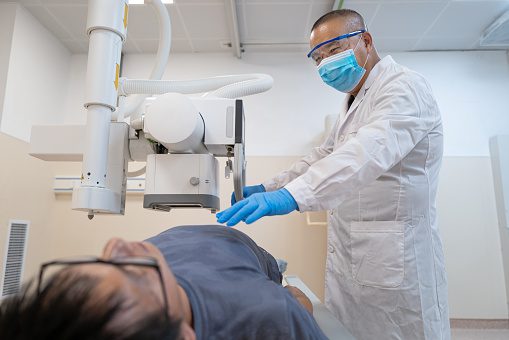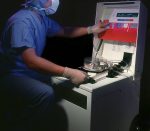
| Radiology Technician Key Stats | |
|---|---|
| Education | 4+ Years |
| Job Outlook | 9% |
Have you ever considered what it would be like to take pictures of the unseen world? How about being a part of a healthcare team that assists doctors diagnose and treat patients? These are exactly the things that a radiology technician does every day.
Consider the possibility to become a radiology technician today and join a growing community of healthcare professionals.
A radiology technician is someone that uses technical medical equipment to do their job.
They must be able to communicate to patients, coworkers, physicians and radiology students which they train.
Taking the next step to a career in the medical field is easier than you may think.
Table of Contents
Education Requirements to Become a Radiology Technician
The road to become a radiology technician can start as early as high school.
Taking courses in math, biology, computer science and communication will help you gain important skills that will carry over into this new career choice.
A high school diploma is essential as there will be college level coursework needed to gain the proper credentials.
Some community colleges offer Associate degrees in radiology which will allow a person to obtain a job in this field.
Most programs include classes in medical math, biology, physics, communication, first aid and radiology specialty courses.
During the program there will be some patient experience that will help prepare students interact with future patients.
Some radiology technicians may choose to specialize in a field such as ultrasound, MRI or CT.
These credentials can be obtained by either employer based training or attending a specialty school.
Large hospitals may train radiology technicians in exchange to work for them for a specific timeframe.
Radiology Technician Job Description
The job description of a radiology technician is based mostly on the technical aspects of operating radiology equipment and interacting with patients.
Nearly all technicians will work with computers as part of their job as healthcare information continues to enter the digital arena.
Here are some common job duties:
- Positioning patients for exams
- Operating radiology equipment
- Explaining technical procedures to others
- Transporting patients to the testing room
- Administrative duties such as scheduling, answering phones and charting
Employment opportunities are also available in mobile imaging.
When a patient is unable to come to a testing facility, then a mobile radiology technician travels to their home to do the examination.
This is one potential job opportunity for those who enjoy traveling as part of the regular job.
Travel jobs also have the flexibility of setting your own schedule, adding to the benefits of this career.
Radiology Technician Salary and Career Path
A radiology technician can earn anywhere from $42,000 to $63,000 a year.
Higher earnings are seen in large hospitals, overtime and on-call shifts.
A private clinic may pay a little less than a major hospital, but the working hours are more “normal” during the day.
Radiology technicians that specialize in a particular area will earn more than someone in general radiology.
It is not uncommon for a radiology technician to work on an as needed basis at multiple facilities; this brings in more income overall over the course of the year.
If you are thinking of getting a job related to radiology, then consider a job as:
- Radiology Assistant
- Medical Assistant
- Medical Office Receptionist
- Certified Nursing Assistant
Making the decision to become a radiology technician is a smart one for anyone that enjoys a technical job and a career in medicine.
This job is similar to a traditional photography career, with a medical spin.
The first step is to find an educational program in your local area.
For more information about the radiology technician profession visit The American Registry of Radiologic Technologists.
![]() The below information is based on the 2023 BLS national averages.
The below information is based on the 2023 BLS national averages.
National Average Salary
$75,250Average Salary by State
| State | Avg. Annual Salary |
|---|---|
| Alabama | $56,670 |
| Alaska | $87,180 |
| Arizona | $79,860 |
| Arkansas | $59,470 |
| California | $103,150 |
| Colorado | $80,140 |
| Connecticut | $85,380 |
| Delaware | $77,350 |
| District of Columbia | $89,740 |
| Florida | $65,640 |
| Georgia | $67,880 |
| Hawaii | $92,170 |
| Idaho | $72,890 |
| Illinois | $74,040 |
| Indiana | $70,550 |
| Iowa | $62,550 |
| Kansas | $67,140 |
| Kentucky | $63,520 |
| Louisiana | $61,480 |
| Maine | $72,210 |
| Maryland | $78,270 |
| Massachusetts | $93,270 |
| Michigan | $68,150 |
| Minnesota | $78,730 |
| Mississippi | $53,660 |
| Missouri | $66,560 |
| Montana | $68,820 |
| Nebraska | $67,530 |
| Nevada | $86,570 |
| New Hampshire | $78,780 |
| New Jersey | $82,800 |
| New Mexico | $71,940 |
| New York | $85,330 |
| North Carolina | $67,500 |
| North Dakota | $68,750 |
| Ohio | $68,140 |
| Oklahoma | $65,810 |
| Oregon | $90,610 |
| Pennsylvania | $69,420 |
| Rhode Island | $83,230 |
| South Carolina | $62,980 |
| South Dakota | $63,590 |
| Tennessee | $62,710 |
| Texas | $72,470 |
| Utah | $72,690 |
| Vermont | $78,170 |
| Virginia | $74,690 |
| Washington | $89,910 |
| West Virginia | $64,580 |
| Wisconsin | $72,200 |
| Wyoming | $72,390 |
| Guam | - NA - |
| Puerto Rico | $31,490 |
| Virgin Islands | $69,360 |
The top earning state in the field is California, where the average salary is $103,150.
These are the top 5 highest-paying states in the field:
* Employment conditions in your area may vary.
Frequently Asked Questions
What is a radiology technician?
Radiology technicians are allied health professionals trained to perform x-rays and other diagnostic imaging examinations.
Their job duties include maintaining imaging equipment, preparing patients for the procedures, protecting body parts that do not need to be imaged by shielding, operating the equipment to take images and they also have to work with physicians to determine if additional images are needed.
Radiology technicians write and maintain detailed reports about their patients.
They may be certified for multiple specialties or may choose to specialize in one of the following fields: x-rays, computed tomography or mammography.
Radiology technicians should follow very strict sanitation procedures to avoid being exposed to infectious diseases and they must wear badges that measure radiation levels and wear protective equipment to minimize the risk of radiation.
Some radiology technicians work evening, overnight and weekend shifts to respond to emergencies.
Radiology technicians need a variety of qualities, including attention to detail, technical skills, physical strength and communication skills.
How much does a radiology technicians make?
According to the Bureau of Labor Statistics, the median annual wage for radiology technicians was $59,520 in May 2018.
Salaries in this field may vary based on the technician’s level of experience, his or her education, and the employer.
Some earn less than $40,000 while others make more than $85,000 a year.
How much does it cost to become a radiology technician?
Radiology technicians need several years of post-secondary education and a state license.
Associate’s degree programs in radiography can cost anywhere between $4,000-$30,000 in total, depending on the school you choose.
State licenses can be earned after graduating from an accredited program and after passing a state exam or obtaining a certificate from a credentialing institution.
The American Registry for Radiologic Technologists is the certifying body for radiology technicians.
What is the demand for radiology technicians?
According to the Bureau of Labor Statistics, employment for radiology technicians is projected to grow 9 percent from 2018 to 2028.
As the baby-boom generation ages, the demand for x-rays and other imaging techniques used to diagnose injuries and conditions such as cancer or Alzheimer’s disease is expected to grow.
How long does it take to become a radiology technician?
Radiology technicians typically need at least an associate’s degree in radiography and a state license.
Associate’s degree programs can typically be completed in around 2 years; 4-year bachelor’s degree programs are also available.
Post-secondary programs in this field combine classroom instruction and clinical training, teaching students about anatomy, pathology, patient care, radiology physics, radiology protection methods, and imaging evaluation.
Licensing requirements vary by state but typically include graduating from an accredited school, passing a certification exam or obtaining a certification from an institution such as the American Registry for Radiologic Technologists.













